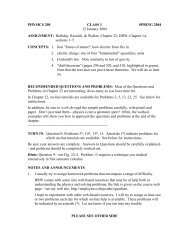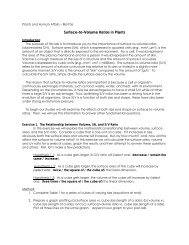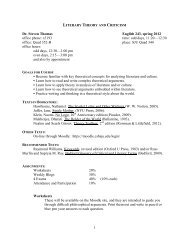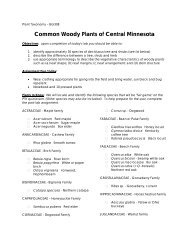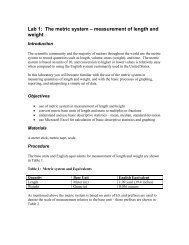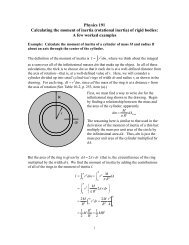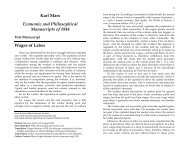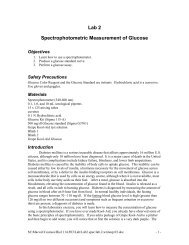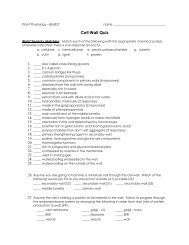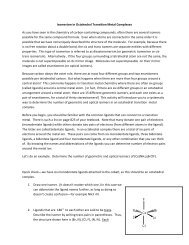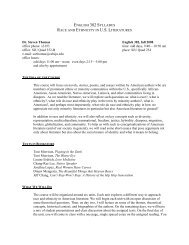Journal of Cross-Cultural Psychology - Employees Csbsju
Journal of Cross-Cultural Psychology - Employees Csbsju
Journal of Cross-Cultural Psychology - Employees Csbsju
Create successful ePaper yourself
Turn your PDF publications into a flip-book with our unique Google optimized e-Paper software.
Lucas et al. / MARITAL SATISFACTION INVARIANCE 111within-culture heterogeneity <strong>of</strong> Chinese marriage in that it comprises both modern andmore traditional arrangements. Similar heterogeneity has also been observed in Turkey(I ⋅ mamoğlu & Yasak, 1997) and undoubtedly exists in many other nations. Generally, then,sociopolitical contexts may create varied criteria for marital satisfaction not only betweencultures but also within them.In addition to the heterogeneity created by sociopolitical variation, differences betweenhusbands and wives from the same culture may also contribute to variability in marital satisfactioncriteria. In this vein, researchers have hypothesized that men and women hold differentinstrumental and interpersonal views not only <strong>of</strong> marriage (e.g., Bernard, 1972) butalso <strong>of</strong> romantic relationships (e.g., Sprecher & Toro-Morn, 2002). One <strong>of</strong>ten overlookedpossibility is that spousal discrepancies in marital satisfaction may also depend on culture.For example, although British husbands and wives may think similarly about romanticlove but differently about spousal support, Chinese couples may agree on aspects <strong>of</strong>spousal support but differ in their views <strong>of</strong> romantic love.MARITAL SATISFACTION AND EVOLUTIONBolstered by recognition <strong>of</strong> both between- and within-culture differences, a generalconsensus is that cultural perspectives on marriage <strong>of</strong>ten emphasize heterogeneous qualities<strong>of</strong> marital satisfaction criteria. A somewhat contrasting viewpoint is <strong>of</strong>fered by an evolutionaryperspective on marriage, in which emphasis is <strong>of</strong>ten given to more universalcriteria. Although evolutionary mechanisms may produce cultural heterogeneity, evolutionaryresearch has tended to articulate a more ubiquitous and primal view not only onmating and marital preferences (e.g., Buss et al., 1990) but also on marital satisfaction(Shackelford & Buss, 1997). In this vein, evolutionary research has revealed that manypatterns in mate selection and marital stability are cross-culturally stable.From an evolutionary perspective, mating behavior—including mate selection, maritalsatisfaction, and divorce—is favored to the extent that it promotes individual reproductivesuccess. Both sexes tend to seek mature, opposite-sex members <strong>of</strong> their species who are notclose kin, which makes adaptive sense. However, men and women also exhibit somewhat differentideal criteria in mate selection. For example, cross-cultural surveys suggest that mengenerally prefer to marry younger, more attractive women who are high in reproductivepotential, whereas women prefer to marry older and wealthier men, who generally excel inproviding material resources and social status for the family (Buss, 1989). Other universalfeatures <strong>of</strong> mating behavior can also be explained in adaptive terms. For example, marital stabilityaround the world is associated with fecundity: the more children, the less chance <strong>of</strong>divorce (Goode, 1993). In addition, divorce in almost every culture is predicted by infertilityand infidelity, both <strong>of</strong> which may hinder individual fitness (Betzig, 1989).Marriage itself may also be interpreted in comparative terms as pair bonding—anevolved characteristic <strong>of</strong> species with highly dependent young that is thought to facilitateparental caregiving (Ember & Ember, 1979; Kleiman, 1977). Humans qualify as belongingto those species with highly dependent young. Therefore, from an evolutionary standpoint,it is not surprising that pair bonding, or marriage, is found in virtually every humanculture and is the generally preferred arrangement for raising children. Evidence aboundsthat children generally develop best if raised by both biological parents (e.g., Amato, 1993;Daly & Wilson, 1988), and marital satisfaction and stability are generally lower withstepchildren than with biological children (Rogers & White, 1998; Teachman & Heckert,Downloaded from http://jcc.sagepub.com at College <strong>of</strong> St. Benedict/St. John's University on April 10, 2008© 2008 SAGE Publications. All rights reserved. Not for commercial use or unauthorized distribution.



